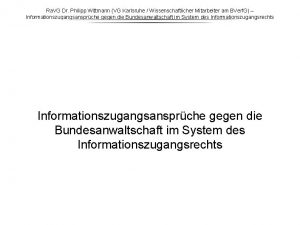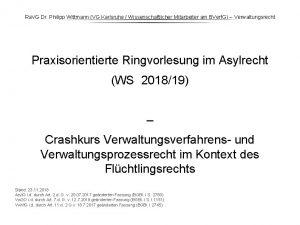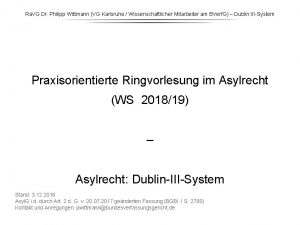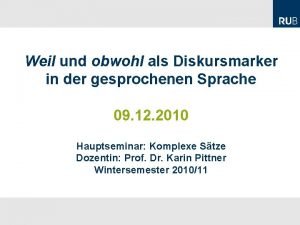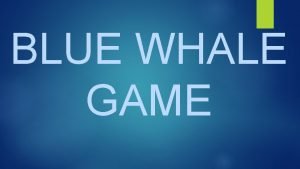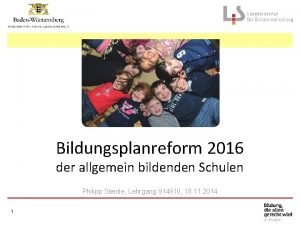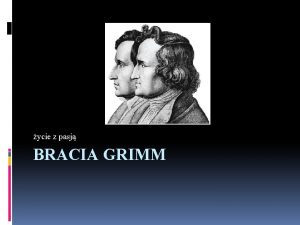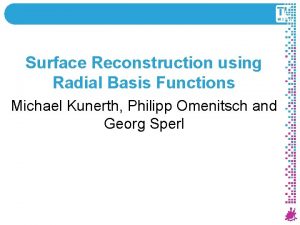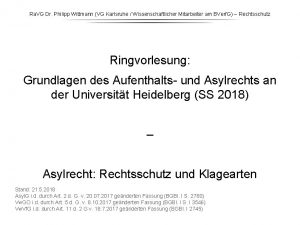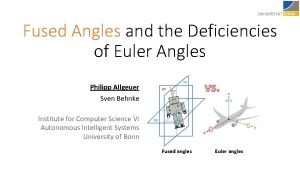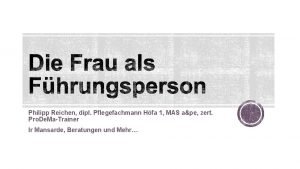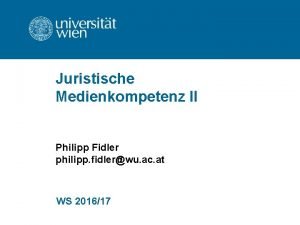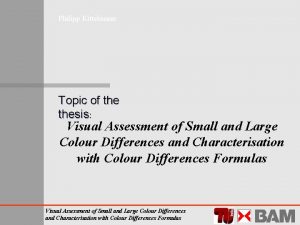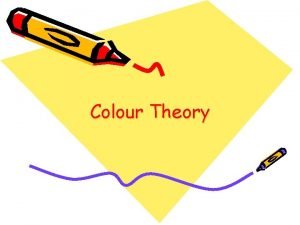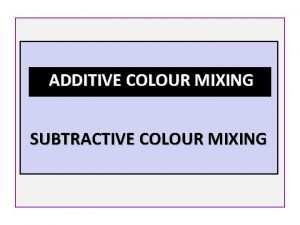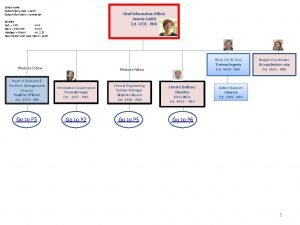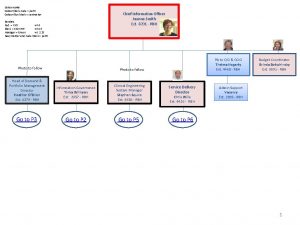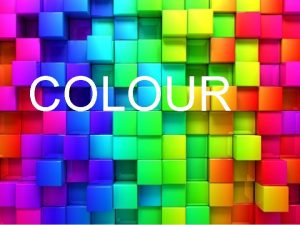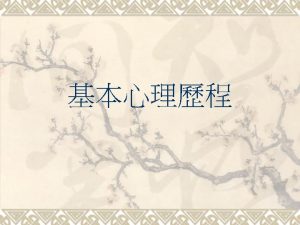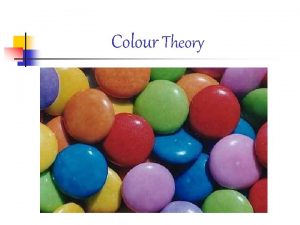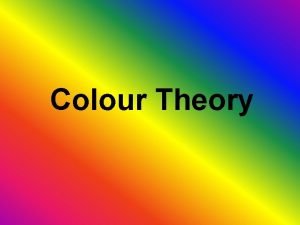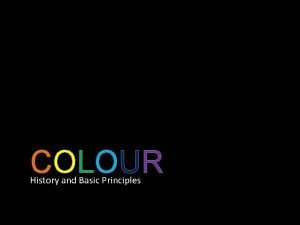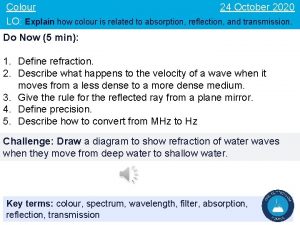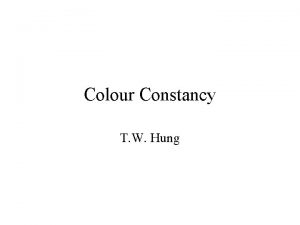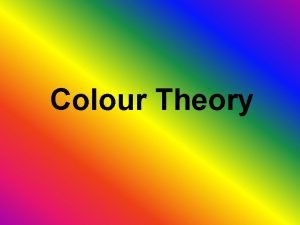Philipp Kittelmann Threshold Experiment Structure Introduction Colour threshold























- Slides: 23

Philipp Kittelmann Threshold Experiment

Structure Introduction Colour threshold experiment Conclusion 21 November 2020 slide 2 of 22 Threshold Experiment

Introduction Colour assessment experiment Surface colours CIELAB colour space 2° standard observer Standard illuminant D 65 45°/0° standard viewing condition 21 November 2020 slide 3 of 22 Threshold Experiment

Statistic 40 person participated in the experiments None of the test persons had experience in colorimetric assessment All test persons had normal colour vision according to the Nagel anomaloskop test 17 women and 23 men have taken part The average was about 25 years. Only six person which were older than 30 participated 21 November 2020 slide 4 of 22 Threshold Experiment

Colour Threshold Experiment Yes/No decision • Test person can see a difference or not Direct contact of the samples • Between the areas was no gap other colour threshold experiments have shown that 25 % of the test persons think to see a colour diffeence when they look at the same colour (hairline, gloss difference effect) Symmetric spread of the CIELAB colours • Consistent spread of the reference colours and colour change in four different directions in CIELAB space 21 November 2020 slide 5 of 22 Threshold Experiment

Princip of the Threshold Experiment The colour differences are created over “addition” of a second illuminant to the standard illuminant D 65 sample second illuminant 21 November 2020 slide 6 of 22 Threshold Experiment

Schematic Experiment Set-up D 65 – simulator observer 65 cm projector with halide lamp colourf ilter grey filter sample 90 cm 21 November 2020 slide 7 of 22 Threshold Experiment

Picture of the Set-up colour filter viewing booth with D 65 illumination Illuminated only with standard illuminant D 65 projector with halide lamp 21 November 2020 slide 8 of 22 Illuminated in Grey addition filterwith wheels a second illuminant Threshold Experiment

Colour Threshold Experiment 98 colour sample with four colour changes per sample • without filter (main change in luminance) • with a red filter (main change in tristimulus value X) • with a green filter (main change in tristimulus value Y) • with a blue filter (main change in tristimulus value Z) 21 November 2020 slide 9 of 22 Threshold Experiment

Analysis of the Threshold Experiment The analysis of the determined colour threshold is separated in two sections 1. Calculation of threshold ellipsoids around the reference colours: • analysis of the calculated colour differences L*, a*, b* • optimization in the CIELAB colour space • colour differences L*, a*, b* as function of CIELAB data L*, a* and b* of the reference colours 2. Comparison of the colour differences calculated by several formulas for the colour threshold: • analysis with the quotient Θ • analysis with the STRESS value S • parametric optimization in the colour difference formulas 21 November 2020 slide 10 of 22 Threshold Experiment

Colour Threshold Ellipsoid L* an ellipsoid is calculated out of the four evaluated colour differences b* cut ellipses in the three planes • • • L*-a*-plane L*-b*-plane a*-b*-plane Δb* ΔL* Δa* the distances of the ellipsoid are calculated in the directions L*, a* and b* • • • ΔL* Δa* Δb* 21 November 2020 slide 11 of 22 Threshold Experiment a*

Colour Data Differences 0. 6 ΔL* Δa* Δb* 0. 5620000001 0. 5 0. 4 0. 301 0. 209 0. 1 0 21 November 2020 slide 12 of 22 Threshold Experiment

Optimization of the CIELAB Colour Space large discrepancy between the colour differences L*, a*, b* next step: optimized in the CIELAB colour space (index o, L*o, a*o, b*o) α = 0, 515 β = 0, 153 21 November 2020 slide 13 of 22 Threshold Experiment

Differences of the optimizied Colour Datas 0, 562 0. 6 0. 5 0. 4 0, 301 0. 3 0. 2 0, 209 0. 148 0. 152 0. 149 0. 1 0 L*, ΔL* L*o 21 November 2020 slide 14 of 22 a*, a*Δa* o Threshold Experiment b*, b*o Δb*

Analysis of the Characteristics of Colour Differences colour differences L*, a*, b* depend very much on the reference colour difference L*, a* and b* as separate function of the colour data L*, a* and b* the following function (polynomial) is used: 21 November 2020 slide 15 of 22 Threshold Experiment

Colour Data Difference L* as Function of L* 21 November 2020 slide 16 of 22 Threshold Experiment

Comparison of the Colour Difference Formulas Comparison of the colour differences E* calculated by several formulas for the colour threshold è the perfect formula leads to the same value for every colour threshold calculation of the quotient Θ und the STRESS value S optimization in the colour difference formulas by their adjustment parameters 21 November 2020 slide 17 of 22 Threshold Experiment

Quotient Θ E*min is the smallest of four colour differences at colour threshold for one sample E*max is the largest of four colour differences at colour threshold for one sample a good quotient is near to 1 21 November 2020 slide 18 of 22 Threshold Experiment

STRESS Value S developed at the university of Granada (Measurement of the relationship between perceived and computed color differences; P. A. Garcia, R. Huertas, M. Melgosa, G. Cui; 2007; J. Opt. Soc. Am. A, Vol. 24 Nr. 7, Seiten 1823 -1829) Ei are the four colour differences at colour threshold for one sample Vi is set 1 four colour differences at colour threshold for one sample should have the same value a good STRESS value is near to 0 21 November 2020 slide 19 of 22 Threshold Experiment

Comparison of some Colour Difference Formulas • values Θ 100 and S 100 are introduced for better comparability • values near to 100 are better Θ 100, s S 100, s optimized parameters Θ 100, p S 100, p CIELAB 29, 800 54, 587 0, 515 0, 153 60, 100 80, 200 CMC 32, 600 56, 937 l 0, 418 c 2, 417 46, 200 71, 436 CIE 94 35, 600 58, 674 KC 4, 432 KH 2, 025 44, 600 71, 371 CIEDE 2000 34, 600 60, 668 KC 2, 953 KH 3, 179 49, 400 74, 041 DIN 99 44, 500 67, 674 k. E 1, 756 k. CH 1, 950 53, 000 76, 549 DIN 99 o 34, 700 59, 367 k. E 0, 776 k. CH 3, 439 48, 400 74, 559 LABJNDS 29, 400 59, 621 a 0 2, 519 21 November 2020 slide 20 of 22 Threshold Experiment b 0 0, 609 62, 700 81, 237

STRESS Value of other Experiment 21 November 2020 slide 21 of 22 Threshold Experiment

Conclusions The yellow-blue difference b* is by a factor 2 larger compared to the red-green difference a* and by a factor 3 larger compared to the lightness difference L* at colour threshold None of the existing colour difference formulas can be used to describe the colour threshold in agreement with Melgosa (2007) For our experimental conditions the colour difference calculation can be optimized by using two parameters. Than a appropriate agreement is reached, but this is no general solution 21 November 2020 slide 22 of 22 Threshold Experiment

END Thank you for your attention! 21 November 2020 slide 23 of 22 Threshold Experiment
 Philipp kittelmann
Philipp kittelmann Philipp gerke
Philipp gerke Dr. philipp wittmann
Dr. philipp wittmann Dr. philipp wittmann
Dr. philipp wittmann Dr. philipp wittmann
Dr. philipp wittmann Weil satze
Weil satze Philipp chapkovski
Philipp chapkovski Philipp chapkovski
Philipp chapkovski Philipp chapkovski
Philipp chapkovski Georg philipp friedrich von hardenberg
Georg philipp friedrich von hardenberg Philipp budeikin
Philipp budeikin Philipp steinle
Philipp steinle Złota gęś baśń
Złota gęś baśń Claudia philipp
Claudia philipp Philipp omenitsch
Philipp omenitsch Dr. philipp wittmann
Dr. philipp wittmann Philipp bertelsmeier
Philipp bertelsmeier Philipp thiessen
Philipp thiessen Z rotation
Z rotation Philipp liegl
Philipp liegl Interne verwaltungsdigitalisierung
Interne verwaltungsdigitalisierung Philipp mager
Philipp mager Philipp reichen
Philipp reichen Philip fidler
Philip fidler


